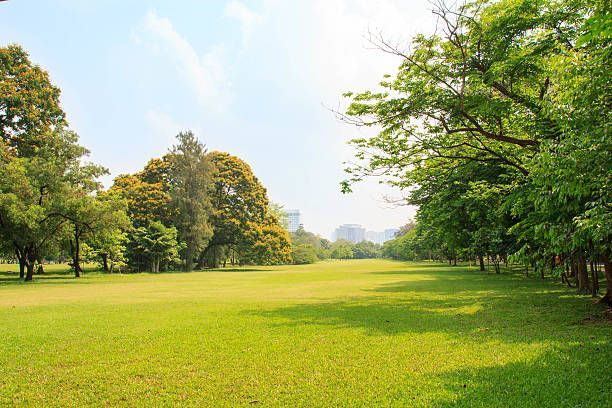How to Create a Pollinator-Friendly Garden with Trees and Lawn
Understanding the Importance of Pollinator-Friendly Gardens

Pollinators such as bees, butterflies, and hummingbirds play a crucial role in our ecosystem by facilitating the reproduction of flowering plants. Creating a pollinator-friendly garden not only supports these essential creatures but also adds beauty and biodiversity to your outdoor space. In this guide, we'll explore the steps to create a vibrant pollinator-friendly garden with trees and lawn, providing a habitat that attracts and sustains pollinators throughout the year.
Pollinator populations worldwide are declining due to habitat loss, pesticide use, climate change, and other factors. By creating pollinator-friendly gardens, we can help provide essential food and habitat for pollinators, contributing to their conservation and promoting biodiversity. Pollinator-friendly gardens also offer numerous benefits for humans, including increased fruit and vegetable yields, improved crop pollination, and enhanced ecosystem resilience.
Choosing Pollinator-Friendly Trees
Trees play a vital role in pollinator-friendly gardens, providing food, shelter, and nesting sites for pollinators. When selecting trees for your garden, consider native species that produce flowers rich in nectar and pollen. Some popular pollinator-friendly trees include:
- Flowering Dogwood (Cornus florida): Known for its showy spring flowers, the flowering dogwood attracts bees and butterflies with its abundant nectar.
- Redbud (Cercis canadensis): The redbud tree produces clusters of pink or purple flowers in early spring, attracting bees, butterflies, and hummingbirds.
- Eastern Red Cedar (Juniperus virginiana): While not a flowering tree, the Eastern red cedar provides important shelter and nesting sites for birds and other pollinators.
- Serviceberry (Amelanchier spp.): Serviceberry trees produce clusters of white flowers in spring, attracting bees, butterflies, and other pollinators. The berries that follow provide food for birds and wildlife.
Incorporating Pollinator-Friendly Lawn Practices: Lawns can also play a role in supporting pollinators when managed with pollinator-friendly practices. Consider the following tips for creating a pollinator-friendly lawn:
- Reduce Lawn Area: Minimize the size of your lawn and replace some turfgrass with pollinator-friendly plants such as wildflowers, native grasses, and flowering shrubs.
- Choose Native Grasses: Select native grass species that provide food and habitat for pollinators, such as little bluestem (Schizachyrium scoparium) and prairie dropseed (Sporobolus heterolepis).
- Mow High and Less Often: Allow grass to grow taller and mow less frequently to encourage the growth of wildflowers and other flowering plants. Avoid mowing during peak flowering times to allow pollinators to access nectar and pollen.
- Avoid Chemicals: Minimize or eliminate the use of chemical fertilizers, herbicides, and pesticides in your lawn care routine. These chemicals can harm pollinators and disrupt the ecosystem balance.
- Provide Water Sources: Set up shallow dishes or bird baths filled with clean water to provide drinking sources for pollinators, especially during hot and dry periods.
Selecting Pollinator-Friendly Plants: In addition to trees and lawn practices, incorporating a variety of pollinator-friendly plants into your garden is essential for attracting and supporting pollinators. When choosing plants, consider the following factors:
- Flowering Period: Select plants that bloom at different times throughout the growing season to provide a continuous source of nectar and pollen for pollinators.
- Flower Shape and Color: Choose plants with a variety of flower shapes and colors to attract a diverse range of pollinators, including bees, butterflies, and hummingbirds.
- Native Species: Opt for native plants whenever possible, as they are adapted to the local climate and provide the most suitable habitat for native pollinators.
- Single-Petal Flowers: Single-petal flowers are generally more accessible to pollinators than double-petal varieties, as they offer easier access to nectar and pollen.
- Group Plantings: Plant flowers in clusters or drifts rather than single specimens to create larger patches of habitat that are more attractive to pollinators.
Some examples of pollinator-friendly plants include:
- Bee Balm (Monarda spp.): Bee balm produces colorful flowers that attract bees, butterflies, and hummingbirds with their abundant nectar.
- Purple Coneflower (Echinacea purpurea): Purple coneflower is a favorite of bees and butterflies, with its daisy-like flowers and long blooming period.
- Milkweed (Asclepias spp.): Milkweed is essential for monarch butterflies, serving as the sole food source for their caterpillars. Planting milkweed provides critical habitat for monarchs and other pollinators.
- Lavender (Lavandula spp.): Lavender's fragrant flowers attract bees and butterflies while providing an attractive and aromatic addition to the garden.
Maintaining Your Pollinator-Friendly Garden: Once your pollinator-friendly garden is established, it's essential to maintain it properly to ensure continued health and vitality. Regular maintenance tasks may include:
- Watering: Provide adequate water to newly planted trees, shrubs, and flowers until they become established. Once established, native plants generally require less water and are more drought-tolerant.
- Mulching: Apply a layer of organic mulch around trees, shrubs, and flower beds to retain moisture, suppress weeds, and improve soil health.
- Weeding: Remove weeds regularly to prevent them from competing with pollinator-friendly plants for nutrients and space.
- Deadheading: Remove spent flowers to encourage continuous blooming and prevent the development of seeds, which can divert energy away from flower production.
- Pruning: Prune trees and shrubs as needed to maintain their shape, remove dead or diseased branches, and promote healthy growth.
Creating a pollinator-friendly garden with trees and lawn not only enhances the beauty of your outdoor space but also provides essential habitat and food sources for pollinators. By incorporating pollinator-friendly trees, implementing lawn practices that support pollinators, selecting a diverse array of pollinator-friendly plants, and maintaining your garden with proper care and maintenance, you can attract and sustain a thriving population of bees, butterflies, and other pollinators. By taking steps to support pollinators, you can contribute to the health of the ecosystem while enjoying a vibrant and biodiverse garden for years to come.
Contact Us
We will get back to you as soon as possible
Please try again later

Website Managed by
Leads By Vinny